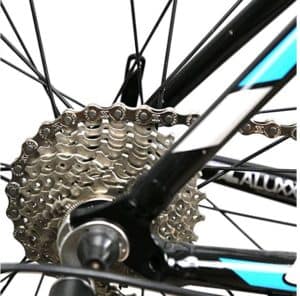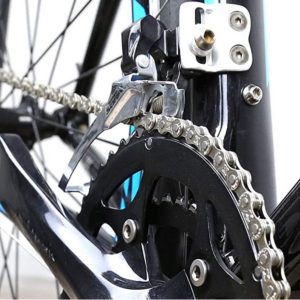A chain tool, sometimes known as a rivet puller or chain breaker, is undeniably an essential tool for DIY chain replacement. But did you know that you can still replace a chain without it? That’s right! And below is a summary of how to change a bike chain without a chain tool.
First, identify if your chain has a master link so that you can disconnect it with pliers. If the master link is absent, find the chain link and disconnect it using a hammer and a nail punch. After that, replace your chain and connect the master link or chain link as it was before.
I’ll explain all these steps in-depth. I’ll also share the things you’ll need now that you won’t use a chain tool.
My goal is to help you replace your chain using standard tools like pliers and a hammer.
You’ll also get some clarifications on the most frequently asked questions about bike chain replacement.
Let’s get into it!

How To Change A Bike Chain Without A Chain Tool
Here are the three steps for changing a bike chain without a chain tool
Step 1 – Remove the Chain Without A Chain Tool (How To Take A Bike Chain Off Without A Chain Tool)
Note that not every bicycle chain has a master link. So, you have first to confirm that it’s there before you can remove it.
If it’s absent, you can move to the next section (about removing the chain link).
Remove the Master Link Without A Chain Tool
Before we can look at how you can remove the master link, we’ve to ask this:
What is a master link, and how do you find it?
Well, a master link is a detachable link (a quick-release) on a bike chain. With it, you can connect and disconnect a bike chain quickly and easily without the need for a chain tool.
A master link usually is shinier than the other links, thus easy to identify. You should, however, clean the chain to enable you to determine it much quicker.
After identifying the master link, disconnect it
The easiest way to release the master link is to twist it using a needle-nose plier like the NEIKO 02105A Long Nose Plier. You can use this plier in a variety of DIY projects and not just chain replacement.
Lastly, pull the master link off
Now pull off the master link after disconnecting it. Considering that its reconnection can become confusing, take a few photos before pulling it off.
If the master link doesn’t pop out when pulling it, tap it with a spanner or hammer, and it’ll oblige.
You can also use this strategy to learn how to fix a bike chain without a chain tool.
But what if your chain doesn’t have a master link?
Then you should look for the chain link and remove it, as I explain below.

Remove the Chain Link Without A Chain Tool
As I mentioned, if your chain lacks a master link, you have to identify and release the chain link.
Here’s how to go about it:
- Put the chain across two wood blocks or any other solid supports to form a bridge-like pattern
- Take the punching tool and put it on one of the chain’s rivets
- Then take a hammer and use it to push out the rivet
- That’ll separate your chain to allow you to remove it easily
Note that you can also use this approach to shorten a long new chain. Remember, chain links should have a smaller and a bigger end for easy connecting.
If that’s not the case, you have to ensure you remain with one big end and another small end.
Step 2 – Put Back the Chain Without A Chain Tool (How To Install A Bike Chain Without A Chain Tool)
Again, we’ve to look at how you can put back the master link and the chain-link separately, depending on what you chose in step 1.
Putting Back the Master Link Without A Chain Tool
It’s easy to put back the master link without using the master link plier.
Here are the steps to follow:
- Hold the master link on your drivetrain’s top end and connect it while the chain rests on the cassette and chainring
- Hold the brakes and engage the pedals to create some tension
- The tension will snap the pins of your master link in place
That’s it! You just put back your master link. If you have a problem bringing the ends together, use a needle-nose plier to squeeze them together.
Putting Back the Chain Link Without A Chain Tool
You can follow these steps to reassemble your chain link:
- Find a stiff wire or hanger and loops its end on the chain
- Bring the ends of the chain together using the wire
- Insert the rivet between the two chain ends
Step 3 – Clean the Chain
The last step on how to replace a bike chain without a chain tool is chain lubrication.
You should clean your chain to get rid of dust, oil, and dirt. That’s possible with a degreaser like the Finish Line 1-Step Chain Cleaner.
Not only does it serve as a chain cleaner, but it’s also a high-quality lubricant. So, you can use it to degrease your chain and lubricate it at the same time.

FAQs on How To Change Bike Chain Without Tool
1. How Do You Shorten A Bike Chain Without A Master Link?
If your chain lacks a master link, you can shorten it using a universal chain tool like the Pro Bike Tool Universal Chain Tool.
It comes with an easy-to-use chain breaker that allows you to shorten your bike chain as much as you want. The fact that it’s a universal chain tool means you can use it on any chain.
2. How Do You Break A Chain Without A Chain Tool?
Here’s how to break a chain without a chain breaker:
Consider hammering a punching tool on the chain’s rivet. You can also strike a slightly blunt nail on the chain rivet.
Alternatively, use pliers to break the bike chain. Furthermore, you can cut the chain short using a coping saw, hack saw, or metal grinder.
3. What Tools Do I Need To Change A Bike Chain?
Essentially, you need a chain tool, which is also known as a chain breaker or rivet puller, to change a bike chain.
Alternatively, you can use a master link plier when dealing with a master link chain. A perfect example is the Pro Bike Tool 2-In-1 Master Link Chain Pliers.
You can use it to connect and disconnect the master link easily. You can also use it to replace quick links in seconds. That’s thanks to its dual functionality.
This chain tool is made from heavy-duty, heat-treated steel to serve you longer.
The tool suits all speed chains which employ a master link, making a fantastic choice for DIY bicycle projects.
Note, however, that you can still learn how to remove a bike chain without a chain tool. In such a case, you’ll need pliers and a hammer.
4. Do All Bike Chains Have A Master Link?
Sadly, not all bicycle chains feature a master link. Master links are typical on BMX and urban bikes.
If your bicycle has a derailleur, the chances are that its chain doesn’t feature a master link.
5. How Do You Remove Links From A Bicycle Chain?
You can remove regular links from a bike chain using a chain tool. You can find a chain tool in any bicycle shop or online, and a good example is the Park Tool CT-5 Chain Tool.
This tool comes in hardened steel construction to serve you longer and generally suit 5-12-speed bicycle chains.
In case you are dealing with splint links, you can remove them using needle-nose pliers. You’ll need to put the chain link between the jaws of the pliers and squeeze them.
6. How Do I Find The Master Link?
A master link is a shiny quick-release that’s usually shiner than the rest. Some master links, especially the Shimano type, have a pin design.
7. How Often Should I Change My Bicycle Chain?
The general rule is that you should change your bicycle chain after cycling for 2000 miles. If you ride aggressively off-road, however, you are likely to need a chain replacement much earlier.
In contrast, if you take care of your chain and drivetrain regularly, then the chain may go more than 2,000 miles.
But to stay safe, use a chain checker like the Park Tool CC-2 to determine if your chain is worn out. If it is, then you should replace it.
Relevant Posts:
Closing Thought:
Generally, you can master how to change a bike chain without a chain tool if you do it more often. Above is a guide that I usually use, which I think is beginner-friendly and worth knowing when you are a DIY enthusiast.